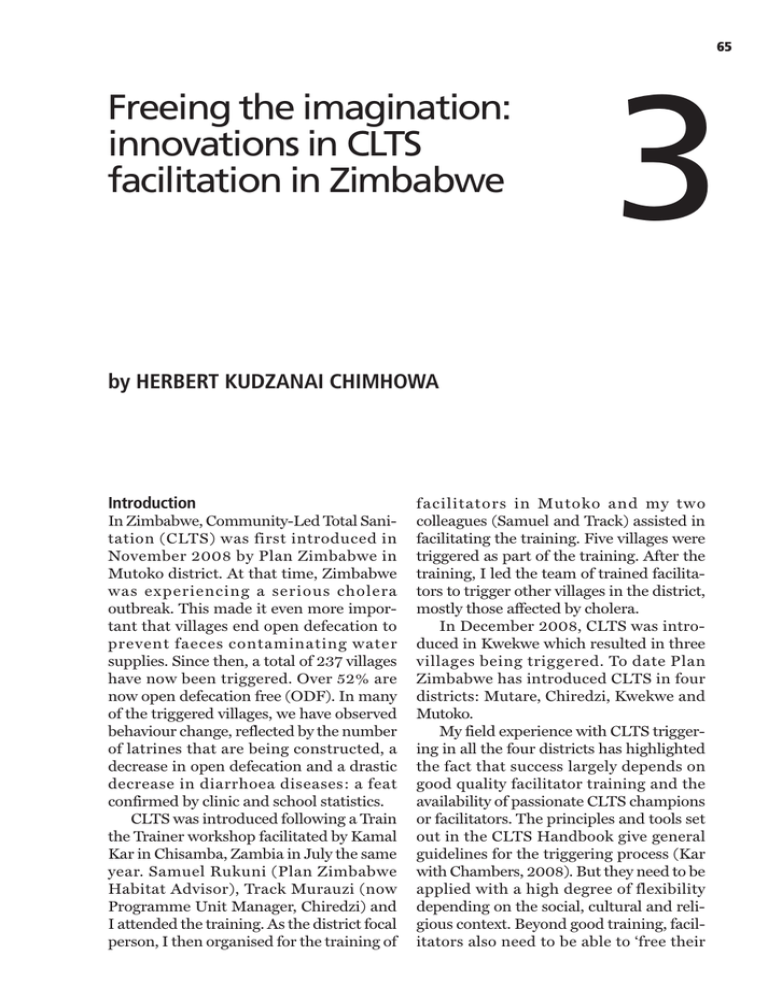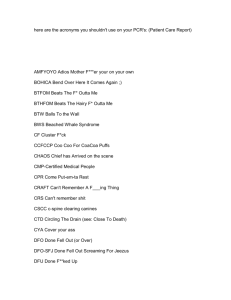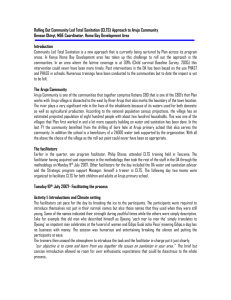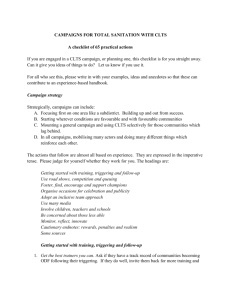Freeing the imagination: innovations in CLTS facilitation in Zimbabwe
advertisement

65 Freeing the imagination: innovations in CLTS facilitation in Zimbabwe 3 by HERBERT KUDZANAI CHIMHOWA Introduction In Zimbabwe, Community-Led Total Sanitation (CLTS) was first introduced in November 2008 by Plan Zimbabwe in Mutoko district. At that time, Zimbabwe was experiencing a serious cholera outbreak. This made it even more important that villages end open defecation to prevent faeces contaminating water supplies. Since then, a total of 237 villages have now been triggered. Over 52% are now open defecation free (ODF). In many of the triggered villages, we have observed behaviour change, reflected by the number of latrines that are being constructed, a decrease in open defecation and a drastic decrease in diarrhoea diseases: a feat confirmed by clinic and school statistics. CLTS was introduced following a Train the Trainer workshop facilitated by Kamal Kar in Chisamba, Zambia in July the same year. Samuel Rukuni (Plan Zimbabwe Habitat Advisor), Track Murauzi (now Programme Unit Manager, Chiredzi) and I attended the training. As the district focal person, I then organised for the training of facilitators in Mutoko and my two colleagues (Samuel and Track) assisted in facilitating the training. Five villages were triggered as part of the training. After the training, I led the team of trained facilitators to trigger other villages in the district, mostly those affected by cholera. In December 2008, CLTS was introduced in Kwekwe which resulted in three villages being triggered. To date Plan Zimbabwe has introduced CLTS in four districts: Mutare, Chiredzi, Kwekwe and Mutoko. My field experience with CLTS triggering in all the four districts has highlighted the fact that success largely depends on good quality facilitator training and the availability of passionate CLTS champions or facilitators. The principles and tools set out in the CLTS Handbook give general guidelines for the triggering process (Kar with Chambers, 2008). But they need to be applied with a high degree of flexibility depending on the social, cultural and religious context. Beyond good training, facilitators also need to be able to ‘free their 61 l Herbert Kudzanai Chimhowa 66 imaginative mind’ and be flexible and vary the tools they use. It is important to innovate with new tools and to consider which tools are appropriate in a given context. Several innovations have been developed and added to the CLTS approach by facilitators and communities during the process of triggering. These innovations have proved very effective at both igniting communities to stop open defecation and building the confidence of facilitators. They have now become part of the repertoire of all the CLTS team members of Plan Zimbabwe and its key partners. In this article I give an overview of some of these innovations. Whose shit is this? During a ‘walk of shame’ to the bush, communities often try to apportion blame for who shits in the open between men and women. When a large fresh shit is found, I usually start by asking the assembled community members, ‘Whose shit is this? Is this from a male or it is from a female?’ This is a question that communities would want to avoid if they can. However, at a time when they least expect it, I ask this question. Arguments follow, with men saying that it must be a woman’s shit because it is so big, and with women saying the opposite. Additional theories can also be raised to determine the source of the shit, such as: ‘Women defecate facing the home and men face the opposite way.’ In addition, some would use the urine deposited next to the shit as proof. ‘If it’s a woman there is a deep small hole created next to the shit.’ By prolonging the discussion in the open defecation area, this adds to the time that the villagers spend looking at a pile of shit, inevitably creating a deeper sense of shame and disgust. the defecation areas used by the community are identified through this process. In the villages, people know who goes where for defecation. But they do not discuss this amongst themselves. In some cases, even those with toilets prefer defecating in the bush arguing that there is fresh air (and therefore less smell) and less likelihood of someone else wanting to use the same place at the same time. This common preference for open defecation can be traced to childhood times when parents used to simply pull down our pants and ask us to go into the field to shit. During the defecation area mapping, I ask each participant to turn to his/her neighbour and ask one another, ‘Neighbour where did you shit today?’ This is our version of a common approach used by charismatic preachers, and one that most church-going communities will identify with. If each one asks his/her neighbour then eventually everyone participates. This tool is particularly handy for me when there is no clear ground surface to draw a village map and all its features. When only the boundary of the village has been drawn, I ask the village people to position themselves where their homestead is located on the map. Whilst the community members are standing, or seated, in the case of the elderly, ill or disabled, they can discuss their shitting places with their neighbours. Participants can then take turns to share with the rest of the community where their neighbours went to shit on that particular day. This leads to much embarrassed laughter and contributes to igniting a sense of shame. During one triggering session a woman even admitted, ‘This morning my two children, my husband who is seated there [a village head] and myself defecated in the open and I can go and show you if you want. The shit shows we ate a lot of shumha [a wild fruit].’ Neighbour, where did you shit today? I use this particular triggering innovation during mapping. It helps to prepare the villagers for the ‘walk of shame’, since all Body viewing Viewing the bodies of departed ones is a common practice during funerals in Photo: Evans Chiduku, Plan Mutare Programme Freeing the imagination: innovations in CLTS facilitation in Zimbabwe 67 A woman who has just finished vomiting during a triggering session using ‘Whose shit is this?’. Zimbabwe. This tool is highly effective in communities where there has been a recent outbreak of cholera and many people have lost loved ones. The facilitator begins by asking the community if any of their members have died of cholera. If there are such cases, the facilitator then tells communities that s/he is sorry about the loss of life and asks them to explain the burial processes in full. If someone has died of cholera, communities will emphasise that no ‘body viewing’ was allowed during the burial process. Instead, the body was wrapped in a plastic bag to 61 l Herbert Kudzanai Chimhowa prevent transmission of cholera. In addition, as the community will explain, shaking hands and serving meals is usually discouraged during such burials. The victim is usually buried on the very same day that they died and the whole process is strictly supervised by government health inspectors. The facilitator then asks a member of the community to explain the process of defecating in the open. Either a community member or a facilitator will demonstrate this whole process by acting it out. Generally, the person explains that s/he walks to a bushy area where there is adequate privacy, makes a U-turn to face the direction that s/he came from and then pulls their pants down to shit. (Apparently the U-turn tendency has been accommodated by almost all toilet designs!). After defecating, the person cleans him/herself using any available material, while holding it with their right hand (except for the lefthanded). After looking at the cleaning material, they throw it away. Then they turn their head backwards to look at the shit, whilst still standing with their legs apart – and I always remark this is ‘some stylish body viewing’. Finally, they pull up their pants before going back. The facilitator ends by asking, ‘Is either of the two scenarios (meaning not viewing the body of a loved one before burial or viewing one’s own shit) a painful experience?’ Normally, the community members say that it is extremely painful not to be allowed to view the body of a deceased loved one before burial. The facilitator then poses the question of whether looking at shit after defecating in the open can be avoided and what this would mean. The fact is that if one uses a latrine there is no way one can view the shit. But the pleasure of viewing the shit after OD is an experience that community members would gladly give up if it meant that their loved ones stopped dying of cholera. That way, when they do pass on, their bodies can be viewed by the community during the funeral. Photo: Khulekani Nkomo, Plan Mutoko Programme 68 A natural leader prepares to take the ‘spirit of the dead back home’. Bringing the spirit of the dead back home In Zimbabwe, once a deceased person has been buried, people will conduct a memorial service. The Christians usually conduct it within six months but certainly after a month, while those who follow the African Traditional Religion will wait for at least a year. Some families will do both. A traditional memorial service is only done for adults. Until the service has been conducted, the living spouse (if any) is not allowed to remarry. The children of the deceased are also discouraged from marrying and may get fined if they do. The traditional memorial service lasts a whole night and involves people drinking beer, singing and dancing. Families brew a special traditional beer for the occasion. Towards sunset on the day of the occasion, a few family members and neighbours visit the deceased’s grave with beer in a clay pot and perform rituals before returning back singing. They call this ‘kudzora mudzimu mumusha’ which means ‘bringing the spirit of the dead back home’. There is a parallel here with the transect walk or the ‘walk of shame’. This is when facilitators insist on being taken on a transect walk to the open defecation Freeing the imagination: innovations in CLTS facilitation in Zimbabwe 69 areas to look for fresh shit in order to shame and disgust the villagers. Often, some community members, for one reason or another, decide to stay behind and not take part in the walk. When fresh shit is found and after some discussion, I ask the villagers whether those who remained behind are experiencing the same feelings as they are right now? If not, what should we do to make them feel the same? I encourage those who are on the walk to carry fresh shit back to the others, saying they are ‘taking the spirit back home’. They will sing some of the composed songs mentioned below (see Box 1) while carrying the shit to the meeting place. This highlights the similarities between the walk of shame and the memorial service. A further link is that shit in the open is also associated with death. Fetching firewood In trying to instil a sense of shame and disgust the facilitator asks communities to list the materials that they use to clean themselves after defecating in the open. Alternatively, this exercise can also be combined with ‘body viewing’ during the discussion of what a person does during the process of open defecation. The ‘fetching firewood’ discussion might go like this: Facilitator: What are some of the materials that we use to clean ourselves after defecating? Community response: Maize cobs, leaves, paper... and sticks. Facilitator: What are the advantages of these different cleaning materials, and what will happen to each of the materials after they have been used? Community response: Leaves, maize cobs and paper are soft and handy. Using a stick limits the chances of one getting shit on your hands but there is a danger of bruising your passage or anus if the stick is not smooth enough. Facilitator: What happens to all these materials after use? Community response: Most materials will decay. Facilitator: All of them? Community response: Usually sticks are picked up by unsuspecting women as they fetch firewood. They are then taken home. (At this point of the exercise, women will show a sense of disgust). Facilitator: Do the women not also use the sticks for roasting meat and green mealies for the men? This is powerful tool in areas where there are forests and the use of sticks, both for anal cleansing and for meal preparation is prevalent. Human/animal sanitation and hygiene practices During the triggering session, when communities have realised that they are eating their own shit, I assist them to go a step further with an analysis to illustrate the inappropriateness of open defecation. I ask the community to name three or four animals, analyse their sanitation and hygiene habits and compare them with those of humans. Do any of the listed animals eat their own shit? The point is to illustrate that no animal, under normal circumstances, will eat its own shit. I remind them of one of their own sustainable agricultural practices. To protect plants from being eaten by animals such as cattle, goats or chicken, communal farmers who do not have the resources to fence off or protect their small fruit trees, usually mix dung and droppings in water and spray the plants. The animals will not eat the plants because of their own shit sprayed on the leaves. This tool makes clear that only humans eat their shit. Your wife is known This one is particularly interesting and I enjoy using it always. It is an innovation by Mr Shepherd T Muchapondwa, a Senior Environmental Health Officer in Mutoko District. Using this tool, I tell the community that on my way to the meeting, I met a 61 l Herbert Kudzanai Chimhowa Photo: Njere Chikaka, Plan Mutare Programme Photo: Gilbert Kambeta, Plan Mutoko Programme 70 A natural leader demonstrates the use of a stick to clean oneself after open defecation. Ignition moment: a woman is visibly angry with the realities of open defecation. man who claims to ‘know’ all the women from the village. Locally, ‘knowing a woman’ means having been intimate with her. Since no man would want his woman to be seen naked by another man, this message shocks the men. I then ask the villagers how it is possible that the man got to know all the women in the village, and it becomes clear that the women were seen defecating in the open. This encourages the men to ‘protect their women’ by constructing latrines. This is important because in many societies, women are not able to construct a latrine without the permission of their husband and it is difficult for them to ask their husbands to construct one. This tool is effective in persuading the men to take action. and medicine for diarrhoea, dysentery and other OD related diseases. It is challenging because they do not seek treatment at clinics and hospitals and would not know the medical costs or expenses. In addition, such costs are irrelevant to them and the tool can also offend them. After realising this, I decided not to talk about treatment but focus the discussion on managing situations that give rise to the need for treatment, such as poor hygiene and open defecation. I now use a verse from the Bible that encourages good hygiene and open defecation. Deuteronomy 23:12-14 teaches about cleanliness in the camp. It reads: Uncleanliness in the camp – a teaching from the Bible Christian communities dominated by certain Apostolic sects which do not believe in scientific or modern medicine initially presented challenges when triggering using the ‘Calculation of Medical Expenses’ tool. Using this tool, families are asked to calculate how much they spend for treatment Designate a place outside the camp where you can go to relieve yourself. As part of your equipment have something to dig with, and when you relieve yourself, dig a hole and cover up your excrement… Your camp must be holy so that He [your Lord] must not see among you anything indecent and turn away from you… Popular songs During triggering, we encourage commu- Freeing the imagination: innovations in CLTS facilitation in Zimbabwe 71 nities to develop songs based on popular traditional and religious tunes. This builds on the role of music in African culture – most cultures have songs which are used for rebuking or mocking as well as encouraging behaviour change. These songs can be a powerful tool for naming and shaming. Facilitators and natural leaders have composed several songs about shit, shitting and open defecation (see Box 1). Conclusion These innovations are not only a result of quality facilitator training. The passion and creativity of the facilitators also contributed to the development of new triggering tools. During training, I advised facilitators that triggering simply aims to create a sense of shame, fear and disgust and that this could be achieved through any other tool other, and not just those we had discussed. I encouraged them to be creative by taking advantage of their understanding of the local languages and some of the common practices, norms and values within communities. I highlighted that most of the tools discussed in the CLTS Handbook focused on common practices and the realities of OD. However, in some cases some of the tools were not as effective on their own – hence the need for facilitators to come up with their own creations, as long as they did not end up ‘teaching, preaching or prescribing’ (from the video, ‘No shit please!’).2 In all this, we need to be culturally insensitive during facilitation. Ever since the training, it has been our practice to hold briefing meetings before and after triggering sessions to share plans and experiences including new tools developed. These meetings assist in ensuring successful triggering is achieved on the first attempt by sharpening triggering skills, since good quality facilitation is very important to successful triggering. I need to emphasise that flexibility with Box 1: Popular songs about shit, shitting, and open defecation These are two examples of songs sung to the tune of religious songs: ‘When you feel like defecating don’t defecate anywhere’ (Kana manzwa dozvi rauya musazomamire pese pese). This is an innovation by Ignatious Mangoti, a talented and experienced CLTS facilitator and health promotion officer. ‘You are the witch shit, you have killed relatives, it is you and no one else who has killed relatives.’ (Ndiwe muroyi ndiwe dhodhi ndiwe wapedza hama, ndiwe muroyi hakuna mumwe ndiwe wapedza hama). And these are two other popular songs facilitators use during triggering: ‘The fly and the shit fell in love and reproduced cholera.’ (Nhunzi nedhodhi zvakadanana zvikazvara cholera). This song was composed by Pedzisai Sigauke, a project coordinator for a local NGO in Mutoko District. ‘Murewa you are a champion, you shit big shit.’ (Murewa makaoma, makaoma murewa munoita hombe). This is usually sung when a big heap of raw shit is found or when shit calculation reveals the large quantities produced in the village. (Murewa is an ancestor’s totem). tools is strongly encouraged so that they are adapted to a specific context. In this way, new and relevant tools can be developed to assist communities to do their own analysis and collectively realise the dangers of OD. It is good practice to share new tools with other CLTS practitioners in other communities and countries. It makes the triggering process exciting and helps build confidence among the practitioners. Innovations should also look at post triggering, verification, certification and celebration of ODF status. Finally, in his video, ‘No shit, please!’ Kamal Kar advises, ‘The journey towards an Open Defecation Free world is long but 2 Watch online: www.cultureunplugged.com/play/556/No-Shit-Please- 72 61 l Herbert Kudzanai Chimhowa worth taking’. My experience is that the journey is exciting and I encourage you to join CLTS practitioners and ODF communities who have embarked on the journey. CONTACT DETAILS Herbert Kudzanai Chimhowa Country CLTS Coordinator Plan Zimbabwe 7 Lezard Avenue Milton Park, Harare Zimbabwe Tel: +263 4 791601-4 Mobile +263 912 355 106/+263 712 943 534 Skype Name: hkchimhowa Email: herbert.chimhowa@planinternational.org REFERENCES Kar, K. with R. Chambers (2008) Handbook on Community-Led Total Sanitation. Plan: UK and Institute of Development Studies (IDS): Brighton, UK. Online: http://tinyurl.com/CLTShandbook. Full URL: www.communityledtotalsanitation.org/resource/handbookcommunity-led-total-sanitation Kar, K., and K. Pasteur (2005) ‘Subsidy or self-respect? Communityled total sanitation. An update on recent developments.’ IDS Working Paper 257, including reprint of IDS Working Paper 184. Institute of Development Studies: Brighton, UK. Online: http://tinyurl.com/IDS-WP-257 Full URL: www.communityledtotalsanitation.org/sites/communityledtotalsa nitation.org/files/wp257_0.pdf Kar, K. (2005) Practical Guide to Triggering Community-Led Total Sanitation (CLTS). Institute of Development Studies: Brighton, UK. Online: http://tinyurl.com/CLTStriggerguide Full URL: www.communityledtotalsanitation.org/sites/communityledtotal sanitation.org/files/Guidelines_for_triggering_CLTS_0.pdf



